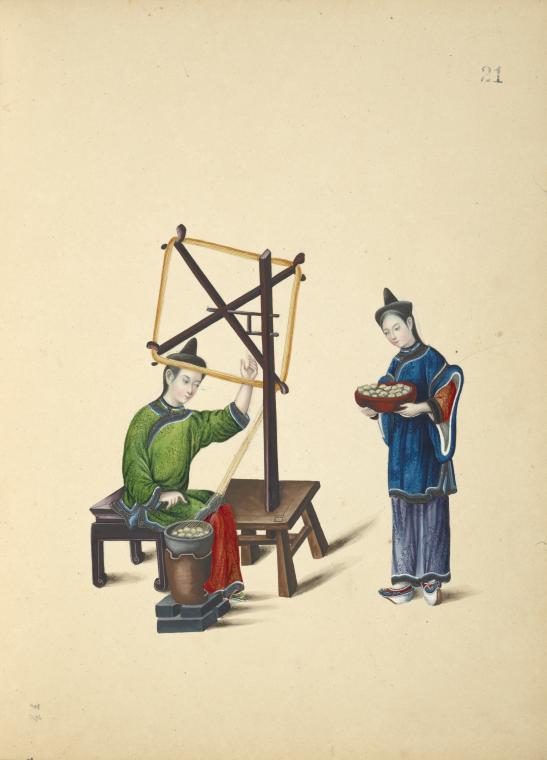|
When people go to a fabric store and ask for "raw silk", or tell you their wedding dress was made of "raw silk"... what do they mean? What is raw silk? There is plenty of confusion about the topic, with common use of the term being very different from technical use in sericulture. I'll start with the technical definition, because it's most precise, then move on to the more popular conceptions and give you better terms for them, so you can find what you want at fabric stores or online! "RAW SILK" IN SERICULTURE Sericulture is the word for the production of silk fibers, through nourishing silkworms and the mulberry plants they feed from, then un-reeling their cocoons. Usually the silkworms are killed inside their cocoons, but not always. Sometimes, they're allowed to leave their cocoons fully developed for ethical reasons, to make the vegan product Ahimsa silk, or Peace Silk. Even in the non-vegan methods, where the larvae are killed, some are allowed to live in order to keep the species going. The way the silkworms are killed (steaming, boiling, being left in the sun) or not killed has an effect on the color and texture of the finished product. Silkworm caterpillars have four glands in their heads. Two of these glands produce a liquid protein called fibroin, which they release through a single spinneret. Fibroin solidifies upon contact with the air, making twin filaments. Each filament is smooth along the length and triangular in the cross sections. However, they're not sticky, so in order to make the cocoon, the caterpillar uses the other two glands to secrete a gummy substance called sericin, which binds the two filaments together and enables them to stick to themselves as the bug wraps itself in a long continuous strand. This Chemistry of Textiles article from the University of West India has a really good microscopic picture (second picture in the Silk section) of the twin filaments, each triangular in cross section, glued together by sericin.
POPULAR MEANINGS OF THE TERM... When people say "raw silk", though, they're not talking about unwashed fibers in a factory. They usually mean silk that doesn't look shiny or that has a rough texture! There are multiple types of non-shiny silk.
DUPIONI The word dupioni (say "DOO-pee-OH-nee") comes from the French word "doupion" which comes from the Italian "doppione", meaning "double". It refers to the "double" cocoons that you get when two silkworms spin right next to each other and their sericin binds the cocoons together. When unreeling these double cocoons, the silk fibers are clumped together at intervals, and the resulting strand has intermittent bulges in it. These are sometimes called "slubs". When the fabric is woven, the slubby threads are used for the warp strands, and they create a regular texture of horizontal ridges. In India, dupioni silk is called PAAT, PAT SILK, or PATTU. This is what many Indians mean when they say "raw silk". I don't know whether pat silk is intentionally woven from double-cocoons or if it's just woven from all the strands produced, both single and double. In US fabric stores, you should ask for dupioni. SHANTUNG Shantung is silk fabric woven from the tussar silk (silk from a different type of caterpillar, often wild and collected from forests) of Shandong, China. The tussar caterpillars produce a more yellow fiber and a shorter strand, because they haven't been selectively bred for hundreds of years. The finished fabric is thinner and finer than dupioni, and has more sheen. Often it'll have two distinct sides, with the one side showing more slubby texture and the other side more sheen. This is not necessary for it to be shantung, though. NOIL Silk fibers are usually long, since each cocoon is spun from a single strand that can be 2,000 to 3,000 feet long! But in its processing, it gets carefully combed and spun, and shorter bits of broken fiber come away. These are called noils. (Say it how it's spelled, to rhyme with "boil".) The fabric made from these short fibers is called silk noil. It has low luster and lower durability, but is soft and drapes beautifully. It looks (to me, anyway) like a cross between dense cheesecloth and cotton flannel that has pilled over time and now has a bumpy surface. Being silk, it is warm to wear, and it is quite nice once you get past the idea that silk should look fancy. MATKA Matka (say "MAHT-kuh") is sometimes called "silk linen" or "linen-weave silk", which is misleading; it's not a silk/linen blend! It is 100% silk, but it looks like linen because it's woven with thicker threads in neutral colors and a plain weave. It has a heavier hand because the sericin is not all washed out, so it doesn't drape well, but it is ideal for suiting and sews easily. TUSSAH / TUSSAR I mentioned tussar silk in the section about shantung, so you may remember that it's silk from undomesticated silkworms. The silk fibers of tussar can be spun finely and woven tightly, so you can get a really lovely fabric from it. For some reason, however, when people say they want a "silk tussah" fabric, they usually mean something in tea-stained or oatmeal color, with thick threads, that looks like a classy version of burlap. This classy burlap is not the only kind of fabric from tussar, but it is distinctive and is often called "raw".
3 Comments
Lottie Smith
9/18/2018 06:37:16 am
Welcomed explanations! Thank you for presenting this info for us (your readers)... very helpful when searching for specific fabrics... now, if everyone just had the same understanding!
Reply
Annie McGee
7/6/2022 12:04:53 pm
Thank You,
Reply
Leave a Reply. |
Karen Roy
Quilting, dressmaking, and history plied with the needle... Sites I EnjoyThe Quilt Index Categories
All
Archives
March 2024
|


 RSS Feed
RSS Feed